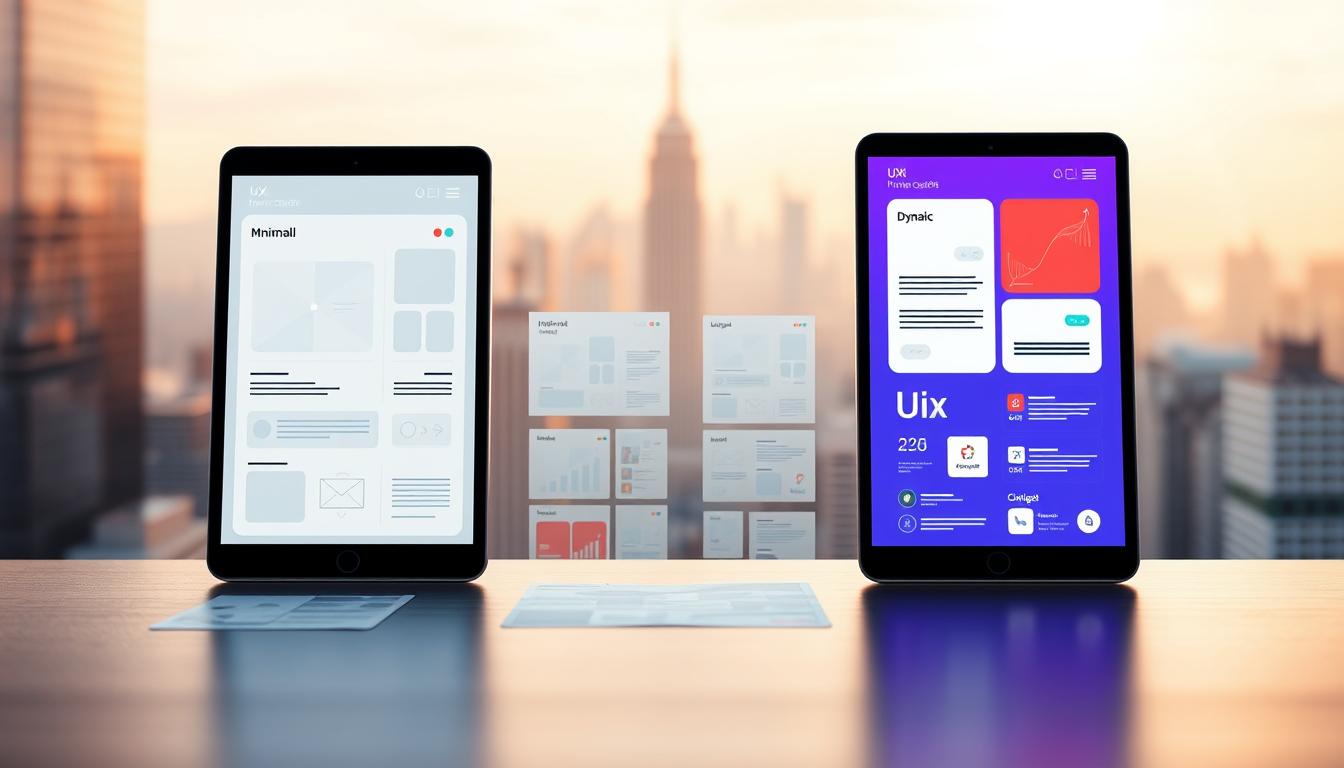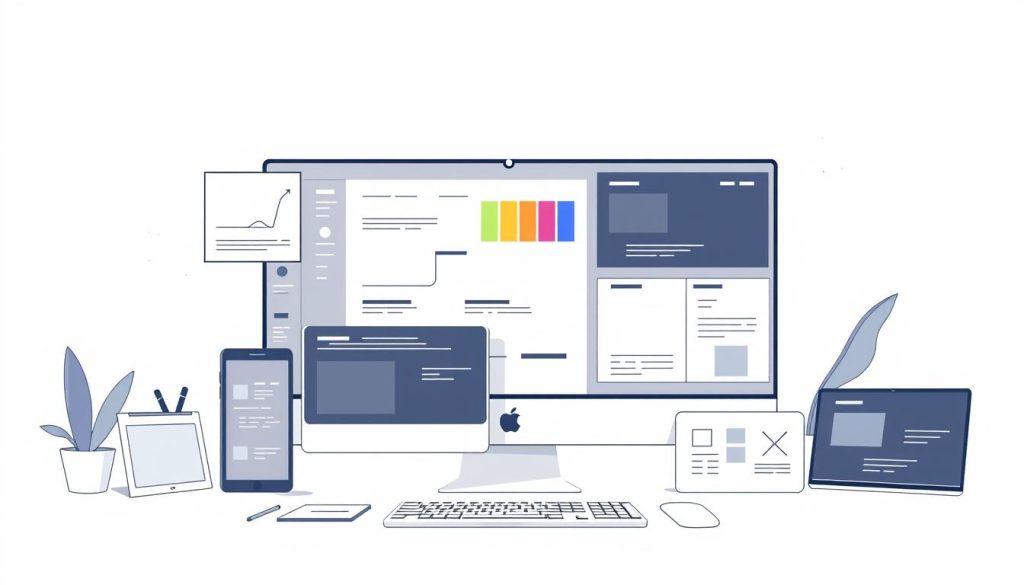Physical Address
304 North Cardinal St.
Dorchester Center, MA 02124
Physical Address
304 North Cardinal St.
Dorchester Center, MA 02124

Ever wondered why some digital products feel amazing while others are a hassle? It’s all about the balance between UI and UX design. Designers work hard to make every tap and swipe on your favorite apps and websites perfect.
UI and UX design might seem like tech talk, but they’re all about knowing what people need. UI focuses on the look and feel of digital products. UX is about making sure everything works smoothly together.
Think of UI as the outfit of a product, and UX as its body and soul. They’re both essential for a great experience. Designers are like digital storytellers, turning user needs into beautiful, useful designs.
User experience design is all about making digital products that really connect with people. It’s about understanding and meeting the needs, expectations, and challenges of users. This happens during their time using a product or service.
The world of digital design has changed a lot over the years. Today, designers know that great products are more than just pretty. They dive deep into how things work and focus on the user.
User experience covers important areas that shape how we interact with digital things:
The roots of modern user experience come from cognitive science and human-computer interaction. Pioneers like Don Norman changed how we think about design. They put user needs first, not just technical limits.
“Design is really an act of communication, which means having a deep understanding of the person with whom the designer is communicating.” – Don Norman
Today’s UI and UX design use new technologies and focus on the user. Recent stats show how good design can make a big difference:
Designers use advanced tools and methods to make experiences that are not just useful but also enjoyable and easy to use.

User experience design is more than just making things look good. It’s about creating meaningful interactions between users and products. UX designers learn a lot about what users need and want through deep research.
The main parts of user experience design are:
UX designers use many important methods. User research is key to understanding how users behave. They use different ways to get insights, like:
“Design is not just what it looks like and feels like. Design is how it works.” – Steve Jobs
Good user experience design needs a team effort. Designers work with others to make products that users love. They aim to solve real problems and make experiences easy and fun.
Designers try to understand what different users need. This helps them create experiences that are not just useful, but also change lives. By focusing on user research and being open to change, UX designers make products that really connect with people.
User interface (UI) design makes complex products easy to use and fun to interact with. It uses design elements that show off a brand’s identity and what users can expect.

Good visual design connects people with digital products through smart choices in looks. It aims to make interfaces that look great and work well.
UI design creates visually appealing experiences that help users navigate. Important visual design rules include:
Interactive parts link users to digital experiences. Key UI design points are:
Typography and color are key in visual design. Strategic font choices and color schemes greatly affect how users feel and engage.
A well-designed interface can increase conversion rates by up to 200%.
Designers must find a balance between looks and function. Every visual element should have a clear purpose in the user experience.

Creating successful digital products needs a strong partnership between UI and UX design. These two areas work together to give users great experiences. UX handles the overall user journey, while UI makes it come alive with visuals and interactions.
The partnership between UI and UX designers involves several key steps:
Prototyping is a big part of this teamwork. It lets designers test and improve digital products before they’re fully made. Studies show prototyping can cut development time by 30% and boost user happiness by 85%.
Key metrics show the power of UI and UX working together:
In the end, successful digital products come from the teamwork between UI and UX. By focusing on user needs, making interfaces easy to use, and always improving design, teams can create products that look good and work well.
UI and UX design is a fast-paced field that needs a mix of technical skills and creative thinking. Designers must be flexible, innovative, and always learning. This keeps them up-to-date in a field that’s always changing.

Digital design today asks for people who can mix technical skills with great communication. Let’s look at the key skills that make top designers stand out.
Technical skills are crucial for good design work. Prototyping is key, as it helps find up to 85% of user experience problems.
Designers also need strong people skills. Empathy and good communication are vital. Teams with high empathy create 60% more innovative ideas.
| Tool Category | Key Software | Primary Use |
|---|---|---|
| Prototyping | Figma, Sketch | Interface design and interaction modeling |
| Visual Design | Adobe Photoshop, Illustrator | Graphics and visual element creation |
| User Research | UserTesting, Optimal Workshop | Gathering and analyzing user insights |
Staying updated is essential, with 92% of UX pros saying it’s key to keep up with new trends and tech. Your dedication to learning will help you succeed in UI and UX design.
The journey to create amazing digital experiences starts with a smart design plan. Information architecture is the core of this plan. It guides designers through a step-by-step method to turn ideas into real products.
Prototyping is a key step in design. It lets designers make ideas real and test them before they’re fully made. The modern UX design process includes these main steps:
“Design is not just what it looks like and feels like. Design is how it works.” – Steve Jobs
Good designers know the process is a loop. Each step gives insights that help shape the next design. Testing with users is key to making sure designs work well and finding ways to get better.
| Design Phase | Key Focus | Primary Objective |
|---|---|---|
| Research | User Needs | Understand target audience |
| Prototyping | Concept Validation | Test design functionality |
| Testing | User Experience | Identify improvement areas |
Working together is essential in design. Designers team up with developers, stakeholders, and users. This ensures the final product meets user needs and business goals. The best designs come from really knowing what users need and always improving.
Exploring career paths in UI and UX design opens up exciting opportunities. The design landscape offers diverse roles for different skills and interests.
Career routes in user research and design fall into four main categories:
For aspiring professionals, understanding salary potential and career progression is key. UX designers can expect an average annual salary of $82,683. Leadership roles command significantly higher compensation:
Specialized certifications like Certified User Experience Professional (CUXP) can boost your credibility. Most entry-level positions require a bachelor’s degree in design or a related field. Strategic skill development in UI and UX can significantly boost your career prospects.
Bootcamp programs offer an accelerated path, lasting 5 months. They cover multiple industry-standard tools. These programs include hands-on projects and masterclasses, helping you build a robust portfolio and practical experience.
The key to success in UI and UX design is continuous learning and adaptability.
Design is more than just looks. User experience and visual design are key to business success online. Companies that focus on UI and UX can gain a big advantage and improve their profits.
The financial benefits of design are huge. Studies show how user experience affects business results:
Investing in user experience design pays off big time. Companies that focus on UI and UX see big improvements in important metrics. For example, making landing pages better can increase conversions by 20% or more.
Measuring user satisfaction means tracking important signs. Key metrics include:
| Metric | Impact |
|---|---|
| User Engagement Time | Increased website interactions |
| Conversion Rates | Higher signup and purchase completions |
| Customer Retention | Reduced customer churn |
Visual design and user experience help build brand loyalty. Consistent design across touchpoints can increase brand recognition by up to 80%. When customers enjoy using your digital products, they’re more likely to stick with you for the long haul.
UI and UX design are key to making digital products successful. Statistics show that 73% of companies see more user engagement when they invest in UX. A good user interface can also increase sales by up to 200%.
UI and UX design is more than a job. It’s a chance to make digital experiences that really count. The best digital products look great and are easy to use. They make users feel like they’re in a magical world.
Designing for users is all about learning and keeping up with new tech. As tech changes, so do what users want. Whether you’re new or experienced, always try to understand what users need.
It’s important to keep improving your UI and UX skills. Stay up-to-date with new tech and always think about how it affects people. The world needs designers who make digital experiences that are useful, fun, and solve real problems.